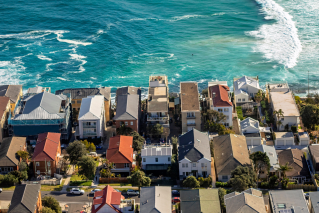‘Roller coaster’: How COVID-19 has changed the property market


The ‘roller coaster’ ride that was COVID for property is still being felt. Photo: Getty
Australia has emerged from COVID-19 with far higher property and rent prices, amid high interest rates and a huge shift in internal migration that has had a lasting effect, new analysis reveals.
CoreLogic research director Tim Lawless said that the four years since the World Health Organisation (WHO) declared a pandemic have been a “roller coaster ride” for property.
“Although lockdowns and the uncertainty of vaccination programs are well behind us, the legacy of COVID will be with us for a long time yet,” Lawless said.
‘Roller coaster’ for property prices
One of the biggest changes since COVID has been the huge increase in property prices, with the CoreLogic national Home Value Index surging 32.5 per cent between 2020 and 2024.
That equates to $188,000 added to the median value of an Australian dwelling.
It hasn’t been a straight line, however, with changes in interest rates and demographics sending values down in the initial quarter after COVID, before a 30.8 per cent spike by April 2022.
After that the market slumped 7.5 per cent as rates began rising, but with migration booming after border restrictions began lifting in 2023, house prices rose another 9.5 per cent in a year.

Source: CoreLogic (click to enlarge).
Rent pain continues
Lawless said another key feature of the pandemic from a property perspective has been the massive increase in rents, which has been particularly acute over the past 12 months or so.
Vacancy rates nationally are just 1 per cent, which has underpinned a 32.4 per cent hike in rent prices since March 2020, equating to about an extra $150 per week to median market prices.
And unfortunately for renters, it doesn’t appear there’s much light at the end of the tunnel either, with other experts predicting pressures to remain throughout the rest of 2024.

Source: CoreLogic (click to enlarge).
Interest rates soar
The future’s looking brighter for home owners though, who should benefit later this year from lower interest rates if the current easing in inflation is maintained.
Lawless said there was much speculation last year about a fixed-rate mortgage cliff, when hundreds of thousands of borrowers would come off COVID rates and face huge bill spikes.
But those fears never materialised, even though many households are reporting financial stress, a strong labour market combined with savings have allowed families to see off the worst.
“So far borrowers have navigated higher mortgage rates much better than expected with mortgage arrears holding below pre-pandemic levels,” Lawless explained.

Source: CoreLogic (click to enlarge).
Demographic destiny
The pandemic has also brought about a series of demographic shifts that are still playing out, including an influx of external migrants to Australia and swathes of local moves.
First, a rush of urban residents leaving big cities during lockdowns for greener pastures in regional New South Wales and Queensland sent prices in those areas skyrocketing.
That’s a trend that’s now normalising, while a huge number of migrants from overseas since borders have reopened has been a key factor driving up prices and rents in big cities.
Lawless said another factor has been changes in household size, with the number of people living in a dwelling falling on average during COVID, and now increasing again.
That’s because people wanted more space during the pandemic when they were spending longer at home, while price rises since have pushed people back towards group living.

Source: CoreLogic (click to enlarge).








